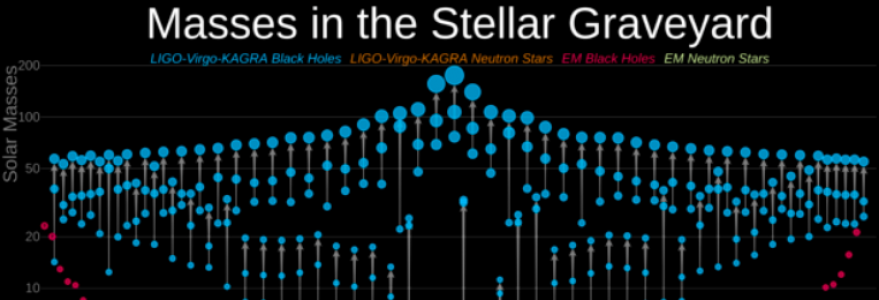35 new events detected by LIGO and Virgo in their latest observation period bring to 90 the gravitational waves detected so far. These events are spacetime quakes generated by the mergers of either two black holes or neutron stars, or black hole-neutron star pairs. The dataset, published in the so-called third Catalog Paper, outlines the features of new populations of black holes, the masses of which, together with those of the observed neutron stars, provide clues about how stars live and die, further broadening the horizons of gravitational astronomy. In the observations took part researchers from the University of Warsaw Astronomical Observatory.
Data from 35 new gravitational-wave events observed between November, 2019, and March, 2020, during the second part of the third and most recent LIGO-Virgo observation period (O3b), bring to 90 the total number of gravitational signals detected to date by the global three-interferometer network.
Most of the new signals originate from the whirling spiral of two merging black holes: cosmic quakes that shake the fabric of spacetime, generating a powerful burst of gravitational waves. Two other events, one already reported last June, were instead identified as mergers between a neutron star and a black hole, a source observed for the first time in this last LIGO-Virgo run. A further event, detected in February, 2020, could come from either a pair of black holes or from a mixed pair of a black hole with a neutron star. Indeed, the mass of the lighter object falls within a range – the so-called mass gap – in which, prior to gravitational-wave observations, neither neutron stars nor black holes were expected to form, and which remains a puzzle for scientists.
“The observed range of black hole masses shows that some of them could have been formed as a result of the collisions in dense clusters of stars,” explains Prof. Dorota Rosińska from the University of Warsaw Astronomical Observatory.
These new detections were published by the Virgo, LIGO and KAGRA scientific collaborations, in the third catalog of gravitational-wave transient sources (GWTC-3), on the ArXiv online archive.
In the observations of LIGO-Virgo took part researchers from Poland, including the University of Warsaw Astronomical Observatory: Prof. Dorota Rosińska, Prof. Tomasz Bulik, Dr. Bartosz Idźkowski, Neha Singh, Małgorzata Curyło oraz Paweł Szewczyk.
The whole article on the discovery is available here >> (credit: VIGO/EGO, Prof. Dorota Rosińska, the University of Warsaw Astronomical Observatory)
More information:
- GWTC-3: Compact Binary Coalescences Observed by LIGO and Virgo During the Second Part of the Third Observing Run: https://arxiv.org/abs/2111.03606
- The population of merging compact binaries inferred using gravitational waves through GWTC-3: https://arxiv.org/abs/2111.03634
- Constraints on the cosmic expansion history from GWTC-3: https://arxiv.org/abs/2111.03604
- Search for Gravitational Waves Associated with Gamma-Ray Bursts Detected by Fermi and Swift During the LIGO-Virgo Run O3b, https://arxiv.org/abs/2111.03608
- GWTC-3 release: https://www.gw-openscience.org/GWTC-3/



